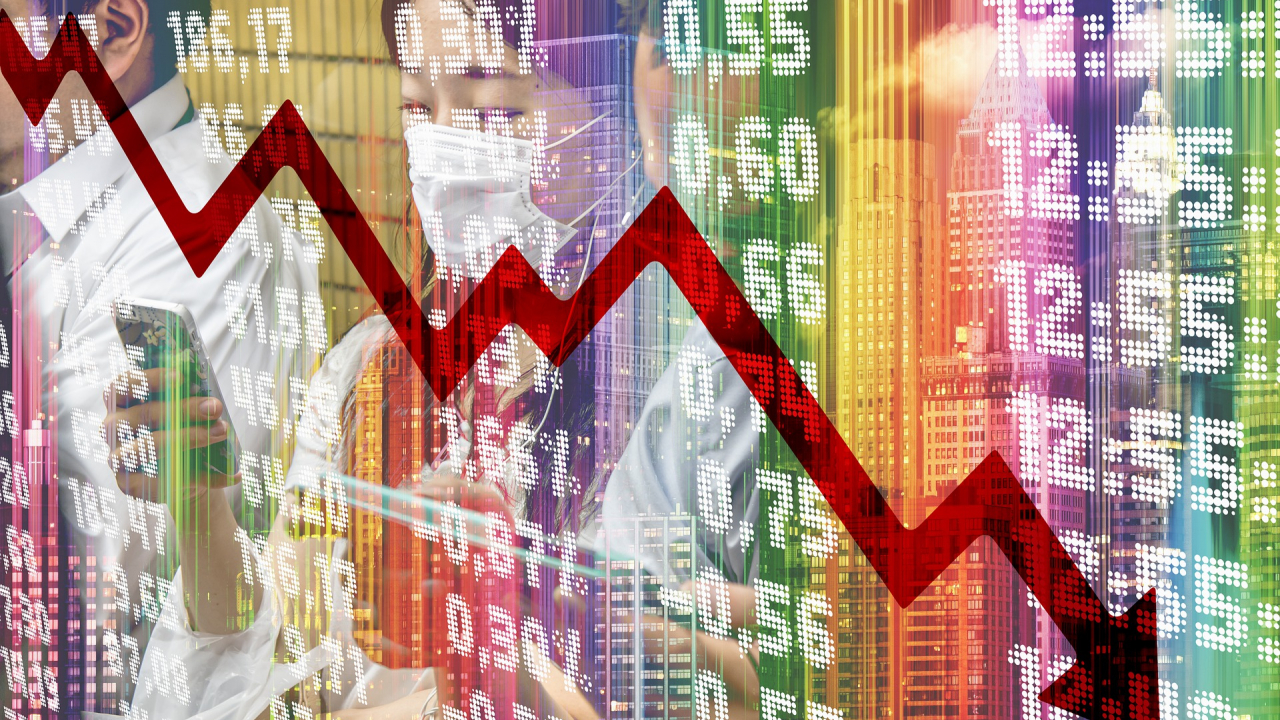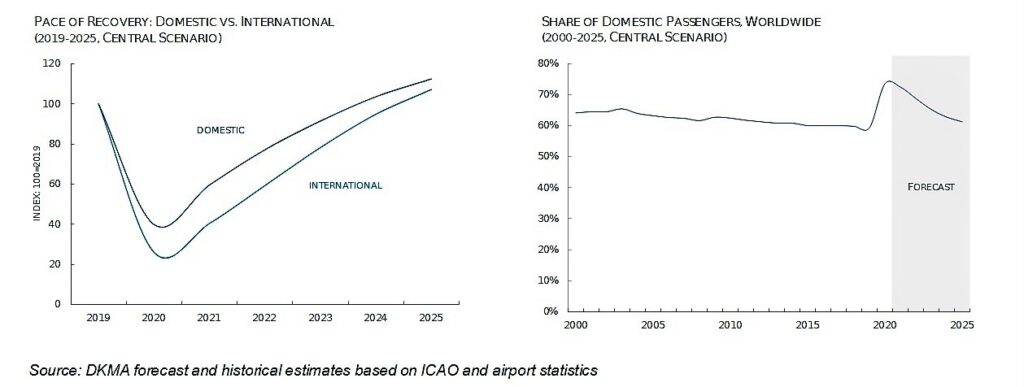A Year Like No Other: the Bumpy Road That Lies Ahead (Part 2 of 2)
Catherine Harmel-Tourneur
June 2, 2021

|
In the second of our ‘A Year Like No Other’ two-part series, the traffic forecasting arm of airport research consultancy DKMA follows up its in-depth overview of air travel demand in 2020 with a focus on the medium-term passenger outlook. |
More than a year after the start of the pandemic the ingredients for a passenger recovery are in place. Specifically there is greater optimism about the economic prospects; unemployment concerns are diminishing, and mass vaccination programs are rolling out. So far, vaccines are proving effective against new variants.
On balance, following a decline of over 60% of demand (see Part 1), global passenger traffic is projected to grow by 23.1% per year between 2020-2025 and 2019 traffic levels are expected to be reached in 2024. However, the road to recovery will be bumpy and, in this difficult environment, some regions are expected to recover sooner than others (see chart below). To bring an end to this pandemic, and for the aviation industry to fully recover, a large share of the world needs to be immune from COVID and the safest way to achieve this is via vaccination. Less than 12 months after the start of the pandemic several effective vaccines have been developed. The challenge now is to administer them as soon as possible.
To bring an end to this pandemic, and for the aviation industry to fully recover, a large share of the world needs to be immune from COVID and the safest way to achieve this is via vaccination. Less than 12 months after the start of the pandemic several effective vaccines have been developed. The challenge now is to administer them as soon as possible.
Rich Versus Poor
For the most part, rich countries have successfully rolled out mass vaccination programs, but poorer countries lag badly. This is because of costs and current production and distribution capabilities that are insufficient to meet world demand. Unfortunately, until a region is largely vaccinated it will be difficult to envision a meaningful recovery for that region.
Vaccination/immunity is a necessary condition, but it alone will not guarantee a full industry recovery. For that to happen, the industry also needs:
- international borders to re-open without quarantine
- passengers to feel safe and confident to travel.
Some governments – and international air transport organisations – are exploring the idea of an immunity passport or testing which would allow a passenger to skip quarantine. While the idea is appealing, making it a reality poses a challenge. Governments will need to coordinate their efforts to harmonize the rules guiding such passports and testing requirements. They will also need to have a coordinated message when communicating the rules of travel to reassure the public that travel is once again safe and reliable.
If this fails, the recovery will probably be slow and torturous and as a stop gap measure we could see ‘international air travel corridors or bubbles’ emerge. While bubbles would be a step in the right direction, they would fall short of a full international re-opening.

Domestic travel has returned much faster than international so far, and bumped up its share of the global market. That is a temporary event based on these forecasts.
Because the domestic market has fewer travel restrictions, people typically feel safer traveling at home. Consumer savings are high and there is evidence of pent-up demand, with several examples pointing to this market recovering first. With regards to international travel, short/medium-haul routes (e.g., intra-Europe) are likely to recover faster than international long-haul, and regions with a high share of international demand such as Europe will take longer to rebound than regions with a high share of domestic travel like Asia-Pacific or North America.
What Does Recovery Looks Like?
We all look forward to the day when the pandemic will be behind us but it’s also safe to say that once it is, the industry will have changed. Several factors will shape the recovery and here we briefly explore two:
- the possible future of the tourism industry
- how people might react once borders re-open.
Many countries/regions around the world – for example Greece or the Caribbean – are highly dependent on tourism revenues and are eager to reopen their borders, but some are taking the opportunity to ‘reset and re-imagine the future’ and avoid ‘over tourism’. In parallel, some experts believe that in the future many tourists will select their destination based on demand predictability, safety and sustainability.
Sustainability – which includes protecting the environment, wildlife and cultural sites – means that a country might choose to attract fewer visitors but focus more on ‘high-value’ tourists to offset the lower numbers. If indeed a post-COVID world includes slower tourism growth, this could impact the number of air travelers and because ‘high-end’ tourists tend to be international, it could also impact the mix of air passengers.
If the world cannot reach herd immunity, and COVID becomes endemic, some countries might become “hermits”. Some, like Taiwan and Australia, have sealed off their borders and have had a ‘zero-tolerance’ towards to the virus. These nations, for the most part are in Asia-Pacific and have been extremely successful at controlling the pandemic. For them re-opening borders will, it seems, inevitably increase the number of infected people in the country.
It is difficult to anticipate the reactions of citizens in those countries, but they might become increasingly risk averse to travelling abroad, or letting foreigners enter. Meanwhile, countries like the US and UK, which have seen travel restrictions put in place but at the same time have had to deal with high daily COVID cases are more ready to accept an increased level of risk in exchange for greater freedom to travel.
So even with vaccine availability, the pace of air transport industry recovery will vary by region and by route network – and once the pandemic is behind us, or largely under control, the industry will not be the same. Until then, we will continue to live in uncertain times with many unexpected speed bumps still ahead.
To receive a copy of the medium-term forecast (Excel Dashboard) please get in touch at: [email protected]
[A Year Like No Other Part 1 can be read here]

